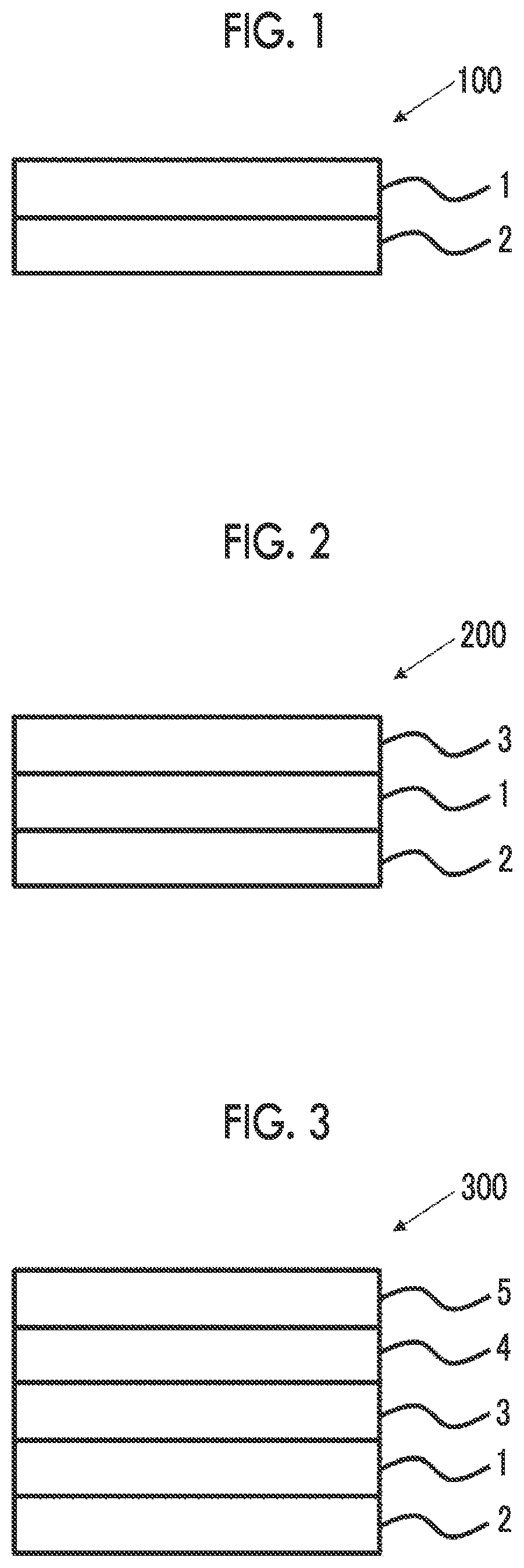Laminate, liquid crystal display device, and organic electroluminescent display device
- Summary
- Abstract
- Description
- Claims
- Application Information
AI Technical Summary
Benefits of technology
Problems solved by technology
Method used
Image
Examples
example 1
Polymerization Example 1
[0495]A mixed solution of ethyl acetate (81.8 parts by mass) as a solvent, butyl acrylate (70.4 parts by mass), methyl acrylate (20.0 parts by mass), and 2-phenoxyethyl acrylate (8.0 parts by mass) as a monomer (A-1), and 2-hydroxyethyl acrylate (1.0 parts by mass) and acrylic acid (0.6 parts by mass) as a monomer (A-2) was charged in a reaction container equipped with a cooling pipe, a nitrogen introduction pipe, a thermometer, and a stirrer, and the internal temperature of the reaction container was raised to 55° C. while substituting the air in the reaction container with nitrogen gas to make it oxygen-free. Then, a total solution of 2,2′-azobisisobutyronitrile (polymerization initiator, 0.14 parts by mass) dissolved in ethyl acetate (10 parts by mass) was added to the mixed solution. After the addition of the polymerization initiator, the temperature was maintained at this temperature for 1 hour, and then ethyl acetate was continuously added into the reac...
example 2
Polymerization Example 2
[0497]A mixed solution of ethyl acetate (81.8 parts by mass) as a solvent, butyl acrylate (96.0 parts by mass) as a monomer (A-1), and acrylic acid (4.0 parts by mass) as a monomer (A-2) was charged in a reaction container equipped with a cooling pipe, a nitrogen introduction pipe, a thermometer, and a stirrer, and the internal temperature of the reaction container was raised to 55° C. while substituting the air in the reaction container with nitrogen gas to make it oxygen-free. Then, a total solution of 2,2′-azobisisobutyronitrile (polymerization initiator, 0.14 parts by mass) dissolved in ethyl acetate (10 parts by mass) was added to the mixed solution. After the addition of the polymerization initiator, the temperature was maintained at this temperature for 1 hour, and then ethyl acetate was continuously added into the reaction container at an addition rate of 17.3 parts by mass / hr while maintaining the internal temperature at 54° C. to 56° C. In a case wh...
preparation examples 1 to 13
[0515](Preparation of Optically Anisotropic Film 1)
[0516]The following composition was put into a mixing tank and stirred to prepare a cellulose acetate solution to be used as a core layer cellulose acylate dope.
Core layer cellulose acylate dopeCellulose acetate having an acetyl substitution100parts by massdegree of 2.88Polyester compound B described in Examples of12parts by massJP2015-227955ACompound G shown below2parts by massMethylene chloride (first solvent)430parts by massMethanol (second solvent)64parts by massCompound G
[0517]10 parts by mass of the following matte agent solution were added to 90 parts by mass of the core layer cellulose acylate dope to prepare a cellulose acetate solution to be used as an outer layer cellulose acylate dope.
Matte agent solutionSilica particles having an2parts by massaverage particle size of 20 nm(AEROSIL R972, manufacturedby Nippon Aerosil Co., Ltd.)Methylene chloride (first solvent)76parts by massMethanol (second solvent)11parts by massCore l...
PUM
| Property | Measurement | Unit |
|---|---|---|
| Fraction | aaaaa | aaaaa |
| Fraction | aaaaa | aaaaa |
| Fraction | aaaaa | aaaaa |
Abstract
Description
Claims
Application Information
 Login to View More
Login to View More - R&D
- Intellectual Property
- Life Sciences
- Materials
- Tech Scout
- Unparalleled Data Quality
- Higher Quality Content
- 60% Fewer Hallucinations
Browse by: Latest US Patents, China's latest patents, Technical Efficacy Thesaurus, Application Domain, Technology Topic, Popular Technical Reports.
© 2025 PatSnap. All rights reserved.Legal|Privacy policy|Modern Slavery Act Transparency Statement|Sitemap|About US| Contact US: help@patsnap.com



